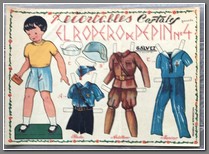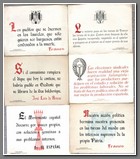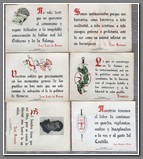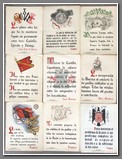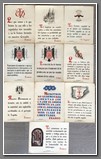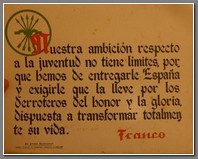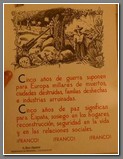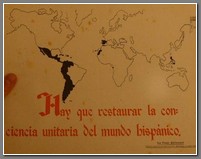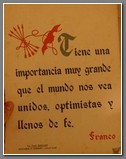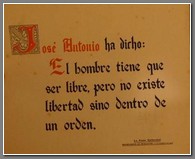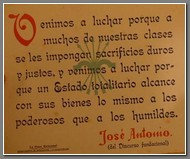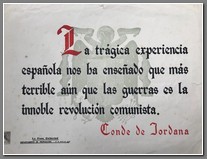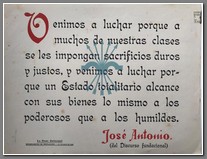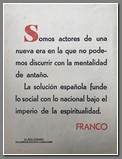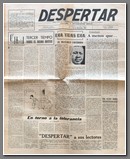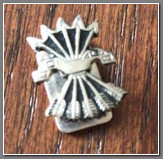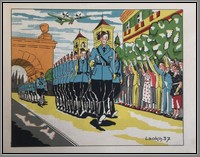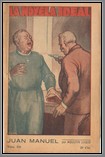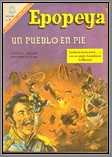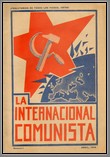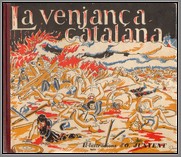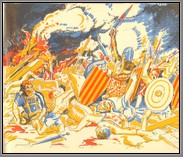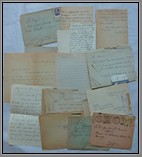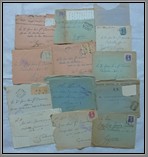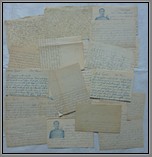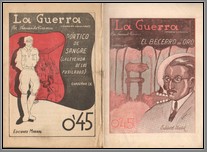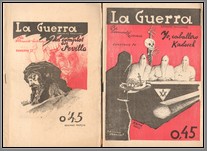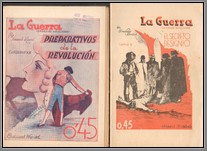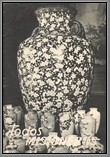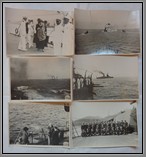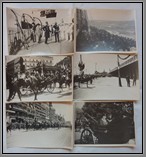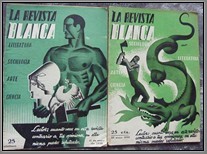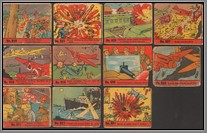Spanish Civil War /History
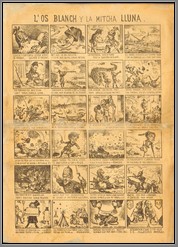 SCW 545Very early Catalan auca telling the story of the 1877-1878 Balkan War. Appears to be critical of Russia. Very rare. Professionally restored. B
SCW 545Very early Catalan auca telling the story of the 1877-1878 Balkan War. Appears to be critical of Russia. Very rare. Professionally restored. B
Price: $800.00
Note: An auca is a graphic format popular in Spain and especially in the region of Catalonia around Barcelona. The genre dates at least to the 17th century but was banned during the 18th century before experiencing a renewal during the 19th and later the 20th centuries as a uniquely Catalonian form of expression. It takes the form of a cartoon or a comic strip, typically with 48 blocks of image and text, although some may have less. An auca is generally produced as a single sheet, but occasionally a booklet form is used. The captions tend to have some sort of consistent rhyme to assist with the flow and storytelling. Many times the term “auca” appears in the title, but another term, “aleluya,” is used, apparently interchangeably. Some sources indicate that the aleluya originated in Castile and originally included religious elements that were shed over time. Auca was a very popular form of anti-Nationalist propaganda during the Civil War.
DESPERTAR. Boletin interno de la Confederacion Nacional del Trabajo de España en el exilio. Cultura e información social. No destinado a la venta pública. (WAKE UP. Internal bulletin of the CNT of Spain in exile. Culture and social information. Not intended for public sale). Printed by Société Gnénérale d'Impression. Toulouse, 1961. Size: 57x45,5 cm. 7 numbers: #1, 12th november to #7, 24th december. 4 pages each one. Visible folds. Editorial secretary: Federica Montseny. Managing director: A. Turmo. Administrator: M. Celma. Complete collection. Published after the CNT was banned, its publication ceased at the end of 1961 for the same reason. B
Price: $2000.00
1937-1938 childrens coloring book by fascist artist Laokin. In 6 frames it glorifies the Nationalist cause, with marching off to war and supported by the people, the support from other fascist nations, triumph over animal-like communists, glorification of the Nationalist cause, Republicans cowtowing to the Nationists and Monarchists. Rare M ah kh
Price: $800.00
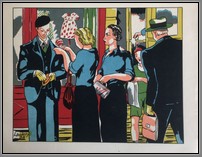 SCW 551 SCW 551 | 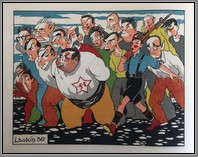 SCW 551 SCW 551 | 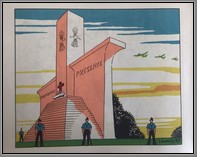 SCW 551 SCW 551 |  SCW 551 SCW 551 |
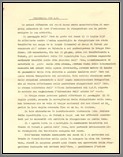 SCW 544Three page manuscript produced by Captain Benedettini Luigi Filippo, with the Italian airforce fighting in Spain. It provides tactical intelligence on the communists on the Ebro front on July 25, 1938. It reads:
SCW 544Three page manuscript produced by Captain Benedettini Luigi Filippo, with the Italian airforce fighting in Spain. It provides tactical intelligence on the communists on the Ebro front on July 25, 1938. It reads:
Reminder per S.E.
The defensive actions of the reds had a surprise characteristic only where the reconnaissance aviation was unable to evolve its activity.
The passage of the Ebro by the reds on 25 July 1938 was carried out while the only reconnaissance squadron had been transferred from the Campo de la Salada (Alcaniz) to the field of Teruel to cooperate in the action on Valencia in which the Italian troops participated. Nonetheless, since June 25, before the transfer to Teruel, the observers of the I20 Squadriglia O.A. they had reported unusual movements on the left bank of the Ebro, setting aside bridge materials on the same bank, they had seen boats hidden near the opposing bank, they had noticed the launch of walkways from the left bank to some islet of the Ebro on which it was transported of the material. These news also result from the reports presented and from the extensive photographic documentation that was carried out in the daily reconnaissance of the Ebro. The same bulletin from the Information Office of the C.T.V. reports the news that saw the intention of the action of the reds.
The red troops were then able to make the passage on 25 July because, once the surveillance of the reconnaissance on the area ceased, they found only a veil of national troops who could not prevent their rapid advance up to one km. from Gandesa.
In this circumstance a section of the O.A. Squadron was immediately detached from Teruel to Caspe with two observer officers for the needs of the reconnaissance service over that area.
On 2 August the whole squadron was again transferred from the Teruel front to that of the Ebro, where I participated intensely in the reconquest of the territory occupied by the reds.
In the action attempted again by the reds on September 9 on the Teruel-Garrion front in which the summit of Creventada was occupied, he was surprised because that front lacked the reconnaissance used on the Ebro sector. To paralyze the action, a bombing formation was sent which, however, was unable to complete the mission promptly due to bad weather conditions that prevented it from seeing the land to be bombed.
Reconnaissance aviation is effectively used in observation, sight, topographical surveying and action tasks on Valencia, in the service of artillery, where it has established itself as extremely useful in the search for enemy batteries (hidden and masterfully masked by the reds) and in the shooting observations. The artillery service was carried out continuously from the early hours of the day until sunset, with the change on the spot after an hour and a half of stay of each plane.
The service rendered with the topographic surveys of the opposing area is very important, which allowed a special observer officer specialized in photographic interpretations and assigned to the Headquarters Command, to obtain all the elements (entrenchments in the woods, works of fortifications, batteries, ammunition depots, encampments) which were effectively beaten by both artillery and air force.
This contribution of the reconnaissance aviation and the delicate work of photographic interpretation have received from Generalissimo Franco and General Kindeland (National Aviation Committee) the highest recognition for the truly invaluable value that it has also in this very important field was able to reach the Italian Air Force.
For this purpose, at the behest of the Generalissimo, a course in photographic interpretation was carried out by Spanish aviators, which was entrusted to the Italian observer officer chosen for the headquarters.
This Officer was also entrusted by the Spanish Command with the task of cooperating in the preparation of topographic maps of the enemy areas, through the exploitation of metric aerial plane works and for this purpose he was sent to Italy to provide photogrammetric materials for expeditious surveys.
Capitano Benedettini Luigi Filippo. M
Price: $100.00
Archive of letters to Jose Luis Garcia Cuerva, mostly from the war. He served with 1st Regiment Flechas Azules, 3rd Battalion, 10th Company. Some are from his brother Antonio who worked for the Comisaria del Estado en la Companis de los Ferrocarriles del Oeste de Espana in Valladolid and another brother Julio from Valencia, both of whom are Nationalists. Some of the letters contain military censor stamps. Another brother, Maruja, writes him from Military Hospital #7 in Valencia. A friend, Benito Martinez, writes to him when he was wounded and staying at Military Hospital #5. Another friend, Pablo Santamaria, worked for the Special Customs Inspection Unit (S.N) shortly after the war. 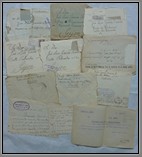 SCW 539
SCW 539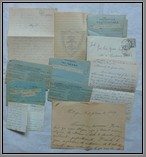 SCW 539Some of the letters are censored. One censored letter from the PNF (Italians that fought in Spain………..there were Italians serving alongside in the same brigade with Cuerva), others from a lawyer Antonio Tapia Seoane in Pontevedra during the war. Cuerva was something of an artist and two letters FROM him during the Ebro Offensive show his artwork. 45 letters (most with covers) and 5 telegrams in all. Majority from the war period. m SOLD
SCW 539Some of the letters are censored. One censored letter from the PNF (Italians that fought in Spain………..there were Italians serving alongside in the same brigade with Cuerva), others from a lawyer Antonio Tapia Seoane in Pontevedra during the war. Cuerva was something of an artist and two letters FROM him during the Ebro Offensive show his artwork. 45 letters (most with covers) and 5 telegrams in all. Majority from the war period. m SOLD
Price: $1400.00
49 letters from a Nationalist soldier fighting at the front. The letters cover the period September 22, 1938 to February 13, 1939. 12 of the letters contain images of Franco. There is one telegram as well as a war time letter to him. The soldiers name was Enrique. He fought on the Catalonia Front and most of the letters date during the Ebro Offensive. m SOLD
Price: $2000.00
Collection of 67 photos, perhaps for the press as text tape on back for most, of the visit of King Victor Emmanuel III to Spain in June 1924. This is an important period in both Spain and Italy as both Mussolini (1922) and Primo de Rivera (1923) had just come to power. This event followed soon after the visit of the Spanish monarchy and Primo de Rivera to Italy. Numerous photos of King Alfonso as the royal family visited Madrid, Valencia and Barcelona. There is one photo of a disgruntled Primo de Rivera with the monarch.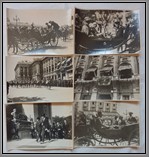 SCW 531
SCW 531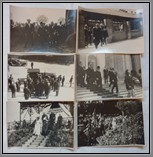 SCW 531 Apparently he was upset that Mussolini did not accompany the royal family to Spain and therefore elected to not accompany any of the events held in their honor. A rare collection of a little known event. m
SCW 531 Apparently he was upset that Mussolini did not accompany the royal family to Spain and therefore elected to not accompany any of the events held in their honor. A rare collection of a little known event. m
Price: $2100.00
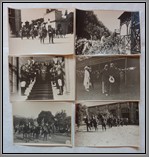 SCW 531 SCW 531 |  SCW 531 SCW 531 | 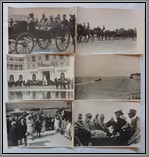 SCW 531 SCW 531 | 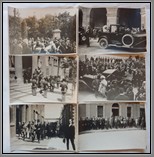 SCW 531 SCW 531 |
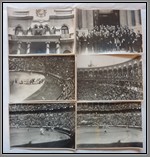 SCW 531 SCW 531 | 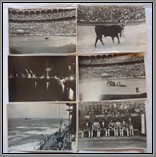 SCW 531 SCW 531 | 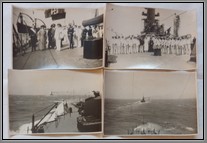 SCW 531 SCW 531 | 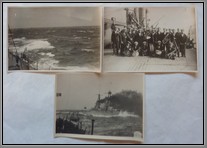 SCW 531 SCW 531 |
A set of 11 American strip cards titled The Nightmare of Warfare c1938. This subset focuses on the Spanish Civil War. Rare. m
Price: $330.00
Note: The anonymous strip card series entitled “The Nightmare of Warfare” was a copycat version of Gum, Inc.’s more elaborate “Horrors of War” set. The design on coloration of the cards and the intentional pirating of titles and text from a competitor all point to the W.S. Corporation as the producer. The artwork is limited to black silhouettes set against yellow backgrounds, with an occasional red accent thrown in. The vertically-aligned backs have the set title, card number, a “series of 48” line, card title, and text – all printed in black ink on gray stock. Since these are strip cards, one or two edges on all cards will be rouletted.

